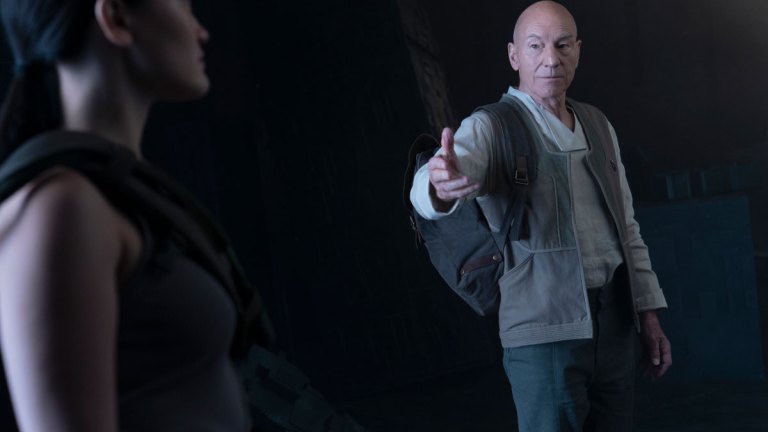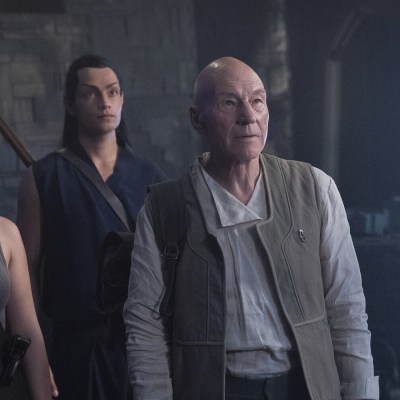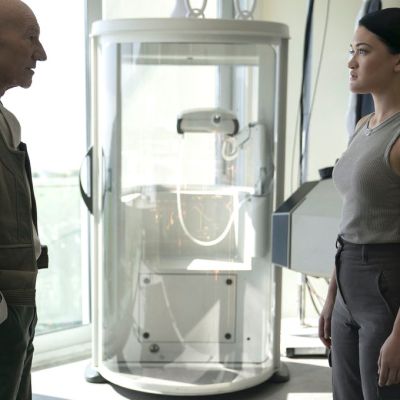Star Trek: Picard Episode 9 Review: Et in Arcadia Ego, Part 1
Star Trek: Picard raises the stakes immensely in the first part of its season finale.

This Star Trek: Picard review contains major spoilers.
However you may feel about the last two episodes of Star Trek: Picard, you have to admit: this show is not afraid to make moves. Last week, we got a pretty eloquently-done info dump about the history of the Zhat Vash and their obsession with killing all synthetic life. This week, we get to meet what appears to be the largest surviving community of synthetics in the galaxy: a hippie commune started by Bruce Maddox and the son of Data’s creator, Dr. Noonien Soong.
I don’t know if you knew this, but androids love flowers. The bigger the better. In what was easily the best cold open of the series so far, La Sirena pops out of the Borg transmat system at Coppelius, Soji’s home planet. Good news? They beat the Romulan fleet by a few days. Bad news? Narek managed to tail them. He engages the La Sirena in a space dogfight and seems willing to die if it means quashing Soji’s synthetic life once and for all. He might have pulled it off, too, if not for a last-minute rescue from the Borg Artifact—that Seven, always saving Picard and friends.
The good guys don’t have time to celebrate, however; massive orchids come up from the surface, swallowing the vessels in orbit around the planet and bringing them down to the surface in their petals. It’s the kind of trippy space creativity (like Discovery‘s fungi network) I like to see on Trek and, a great WTF moment to start the episode heading into the show’s theme.
While the orchids may have given the La Sirena a “ride” down to the surface, they also knock out the ship’s systems and, oh yeah, they knock out Picard too. It seems his terminal brain condition is getting worse. Once conscious again, Picard tells his crew the truth about his medical condition, spelling it out for the viewer as well: he’s dying. And they’re not to talk about it, OK?!
Picard’s lucky in the sense that the crew has a mission to focus on and to (mostly) distract them from their friend’s impending death. First, they plan to check on the fallen Artifact, which hit Coppelius harder than La Sirena did, and then they will travel to Soji’s home to warn the synths about the coming Romulan invasion.
The gang finds Seven, Elnor, and the Ex-Bs doing pretty well, all things considering. (Picard and Soji are met with the news that Hugh died at Narissa’s hand.) In fact, in most ways, the Artifact is doing better than La Sirena: it has some of its systems online, including long-range sensors. Raffi uses them to check on the Romulan invading force: 218 warbirds, incoming. Picard & co. leave Seven and Elnor to their Artifact work and set out to warn the synths.
Soji easily finds the synth settlement. The community is one part SoCal yoga retreat, one part laidback Silicon Valley office, and all parts Free People photo shoot. With all of the bare midriffs and brights colors, it also looks like it could come out of a particularly campy episode of The Original Series or The Next Generation, which I find particularly endearing and, somehow, refreshing amidst the generally sleek, shiny, monochrome aesthetics of many modern TV series will similar AI themes.
The group is welcomed to the community by Arcana (sadly, there are no tarot card readings in this episode) and self-described “mad scientist” (red flag!) Dr. Altan Inigo Soong, and it is so great to see Brent Spiner back in action in some way. While we’ve seen glimpses of Spiner as Data in dreams and flashes of memory, this is his first proper chance to utilize the on-screen charisma that always made him so watchable as Data and in other Trek roles.
While Synthville may have the feel of a chilled out community, it’s a fearful one, too. The synths who live there have been hiding for a reason: their very existences are always threatened by the single-minded hate of the Zhat Vash. This has made members of the synth community paranoid, namely Sutra.
Sutra (played by Isa Briones, who really demonstrates her acting muscles in this episode) is the sister of Jana, one of the two synths Rios saw his captain murder by command of the Federation nine years ago. Given this backstory, it’s easy to understand why Sutra may be particularly fearful towards “organics.” Fear can drive us to do terrible things, and synths are no different. When Agnes shows Sutra the Admonition, Sutra doesn’t see it as a warning, but as a promise: if synth life is threatened, as it has been by both the Federation and the Romulans, then their is a synth civilization out there willing to swoop in an “excise” synthetic life from organic oppression—or at least they were there thousands of years ago.
Sutra sees her opportunity. She kills Arcana and frames prisoner Narek for it, using the murder as a rallying call for her fellow synths. She asks that they send a message to the synths who sent the Admonition message for help before the Romulan fleet arrives. Picard tries to use his vast diplomatic skill to convince the community otherwise. They can all fit on the La Sirena, he tells them; there is a way other than violence against the Romulans and, past that, potential mass murder of all organic life in the galaxy.
But the synths are easily swayed by Sutra, and Picard can’t even get support from Soji, who has been grappling with where she belongs and what choice she should make in this high-stakes quandary. Soji publicly sides with Sutra, as does Agnes, though I wonder if this is part of a larger plan that will inevitably see her support Picard.
It’s an unsettling end to the first part of a two-parter that is hard to judge in terms of characterization, as we have yet to see how honest both Soji and Agnes are being in their public announcements of allegiance. The climax is somewhat undercut by the fact that we have spent so little time in Synthville, and therefore understand so little about who these people are, how they function as a community, and how strong Soji’s connection to them truly is. For now, however, it sets up a high-stakes scenario for the Season 1 finale, in which the very fate of the human race is at stake.
Additional thoughts.
- Seeing how the different characters reacted to the wonder and terror of going through the Borg transmat network was a great, efficient character-building moment. (Mostly, it was Agnes freaking out and everyone else having the time of their lives.)
- “There’s a difference between killing an attacking enemy and watching a wounded one die.” Put this one on the Picard Wisdom of the Day Calendar!
- Rios is very committed to smoking his cigar.
- The visual of the Borg Cube coming through the
- “Et in Arcadia ego” is a 17th century French painting also known as “The Arcadian Shepherds.” Painted by Nicolas Poussin, “Arcadia” is often interpreted to represent a kind of paradise. The phrase “Et in Arcadia ego,” is translated as “Even in Arcadia, there am I,” the “I” widely presumed to be “Death.” Presumably, the synth community represents “Arcadia,” which makes this allusion pretty damn ominous.

- Whenever anyone on this show talks about “synths,” it makes me think of the excellent Humans, which ran for three seasons on AMC, and explored the social, cultural, and political repercussions of a modern reality in which anthropomorphic robots have been integrated into everyday life. I think this is my main holdup with the central plot of Picard: We’ve seen it before, in Humans, Battlestar Galactica, and elsewhere.
- The series continues to explore the line between Picard’s deep empathy and compassion with his deep discomfort with sharing his feelings. We see this in his request that no one treat him like he is a dying man and, later, more effectively, in his conversation with Raffi. Raffi knows Picard better than anyone else on the La Sirena and while, she has been angry with him for a long time, she still recognizes all of the good he has brought into her life. We also have seen her to be a character who is comfortable with expressing and discussing emotion. She takes the opportunity to thank her JL, and to tell him that she loves him. He returns the sentiment, much more stoically, but none the less honest for that stoicism. It’s a nice echo to the scene in the previous episode that saw Picard discussing whether or not Data loved him with Soji. Picard and Data loved each other, even if they never had the chance to say it; he won’t miss an opportunity to express that love to Raffi. Not this time.
- The show also continues to play it fast and loose with the ethical consequences of Agnes’ murdering Bruce Maddox. Like, I know she feels real bad about murdering her ex (and Alison Pill is very good at crying), but for a show that is desperate to define some kind of moral code when it comes to subjects like treatment of synths, the Romulan refugee crisis, and the Federation’s role in both, Picard has been wishy-washy when it comes to Agnes. On the character level, it feels like a missed opportunity to explore how each of the La Sirena characters think justice should be handled. Dr. Soong’s admonition of Agnes’ actions is an important moment, but one undercut by the implication that it seems to be, at least in some part, a manipulation. Soong needs Agnes’ help to transfer his consciousness into a synthetic body (classic Dollhouse!). On a plot level, “the Admonition really f-ed her up” is an important contextual factor, but it is a missed opportunity to articulate the kind of power the message has—does it influence or does it control? This feels like an important question to answer.
- Picard is still trying to sell me on this Rios/Agnes business, and I… am not sold.
- Not sure how I feel about Sutra’s ability to learn the Vulcan mind meld.
- Meeting Sutra makes me appreciate Isa Briones’ skills.
- Initially, Seven and Elnor’s decision to avoid the main action felt like a somewhat contrived setup for a spinoff show, but with Narek heading back towards the Artifact at the end of the episode, now I am less sure.Would you watch a Seven/Elnor spinoff?
- Sign my petition for Elnor to give someone a hug in every episode? Oh my god… what if someone gave Elnor a hug?
- Thus far, Picard has been using groups like the synths and the Ex-Bs, in part, to explore how those in power and privilege treat vulnerable populations of “others.” I’m not sure how turning the synths into a super powerful force that is considering wiping out all of organic life fits into that allegory.


